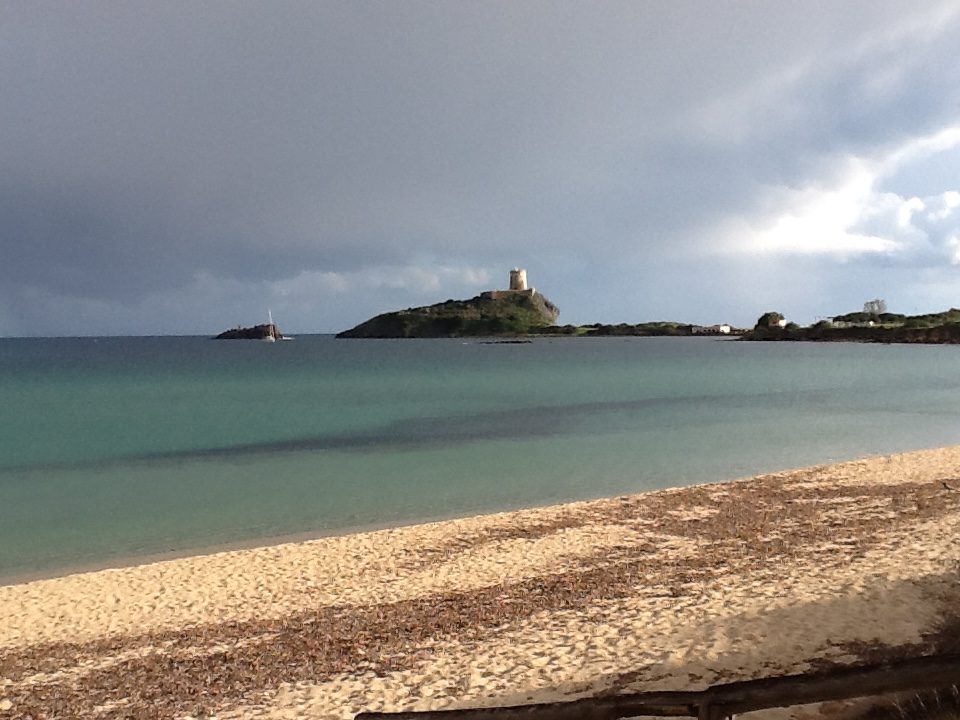
I waved goodbye to Black Swan early November and caught the ferry from Carloforte to the Sardinian mainland to Portovesme. After docking I boarded the shuttle bus to the Cagliari the old capital of Sardinia.
I had planned to visit the old Punic Roman archaeological site at Pula. Once I arrived at the Bus depot I took a coffee at the adjoining Macdonald restaurant while waiting for the autobus to Pula.
At the autobus platform I was surprised at the throng of people waiting to get on the 15.20 bus to Pula. “Crikey Pula is a popular place” and in November, strange? Why so many people all trying to get on this one bus?
A bendibus came in to the platform, “well maybe that should be big enough for us all to get on?” There was lots of pushing, shoving and irate voices from the crowd all trying to get onto the bus at once. These people are not like us orderly queuing Brits! Standing room only for tail enders, me included! Poor Bus couldn’t move, it was too overloaded! Quite a few had to disembark for another bus.
Arriving at my digs in Pula I explained to Franco, the landlord, about the fully loaded bus “what’s happening in Pula” I asked? There’s a jewish hotelier in Pula that arranges holidays with an Israeli armament factory for its workers. Hence the reason why the people onboard didn’t speak Italian and some of the men wore a kippah.
Pula has a rocky Isthmus that’s sticks out into the sea and gives protection either to the westerly or easterly winds which makes ideal anchorage with nice sandy bottom. The Phoenicians built a settlement on this rocky isthmus having two fresh water rivers coming down from the mountains close by. However after the Punic wars the Romans reoccupied the site for its excellent anchorage and strategic qualities.
The Roman remains are certainly a worthwhile visit and it has a lovely “Blue flagged” white sandy beaches with crystal clear inviting water. Unfortunately the weather had changed with constant dark cumulus clouds with intense intermittent rain showers producing cooler temperatures, a little late in the season for actually sunning ones self on the beach!
The Mediterranean weather usually breaks at the end of October, and the weather changes quickly from blue sunny skies to changeable cloudy weather conditions with drops in barometric pressure. Last year in late October Italy experienced strong southerly winds and heavy rain. Venice was flooded and again this year, this being a 50 year high water record. Venice’s geographical location at the top of the Adriatic means when high winds blow from the south water is funnelled up towards top of the Adriatic and Venice being on a low lying lagoon and in the wrong place takes a serious hit!
Katabatic winds which is cool air forcing downwards from the surrounding land are famously recognised by seafarers in the Med: Mestrale (NW), Scirocco (SE) Levante (E) Greco (NE) Ponenet (W) and so forth.
I have onboard great little instrument called a Kestral its hand held multi functional device which measures, wind, temperature and barometric pressure. I check it each morning it gives an excellent indication of pressure changes any quick change and of course visual cloud signs I know that there we will be in for a blow. I also use Passageweather.com and windy.com when passage planning.
Windy gives good overview, Passage weather I look at for wind direction and wave height and barametric pressure isolines in more detail. Sailing in the Mediterranean can be tricky for its changeable winds and directions.
Timing is very important I would even say critical. Fortunately in most cases the winds don’t have a long fetch across the sea to build up massive waves. However the winds produce short waves which can make forvery lively sea conditions, especially around cape headlands which act as a venturi effect to accelerate wind speeds.
Next years plans is to watch the Americas Cup new series of AC75 monohull foils racing in Cagliari bay near end of April 2020. Luna Rosso the Italian Prada team have been doing performance trials and the series should produce some spectacular racing. I think this series is over 4 days. 24-28 April 2020. Once they finished I’ll head off down to Tunisia to Sidi Bou Said to try see more of Carthage punic roman remains then head east via Malta to Greece to the Paloponnese at Kalamata. I would love to motor sail through Corinth canal into the Aegean Sea maybe later in the year, we’ll see? Watch the space!
https://youtu.be/hNACQMuUXh8https://youtu.be/2jYhbaHT1uc
2 Comments
Cathryn
Great blog! Do you have any tips and hints for aspiring writers?
I’m planning to start my own blog soon but I’m a
little lost on everything. Would you propose starting with
a free platform like WordPress or go for a paid option? There are so many options out there that I’m totally confused ..
Any tips? Bless you!
Paul
Hi Cathry, first write about things that really interest you something you want to know more about yourself? If like me you like reading and you have a passion for something that’s a good start.
Keep a notebook or use the notebook on your phone if something catches your interest put not down on your blog idea page.
Think about the blog idea do some research look into in detail. Then summarise highlight what’s interesting to you. With blog write what you find interesting your your own critic. Enjoy the process of writing and educating yourself at the same time. Paul